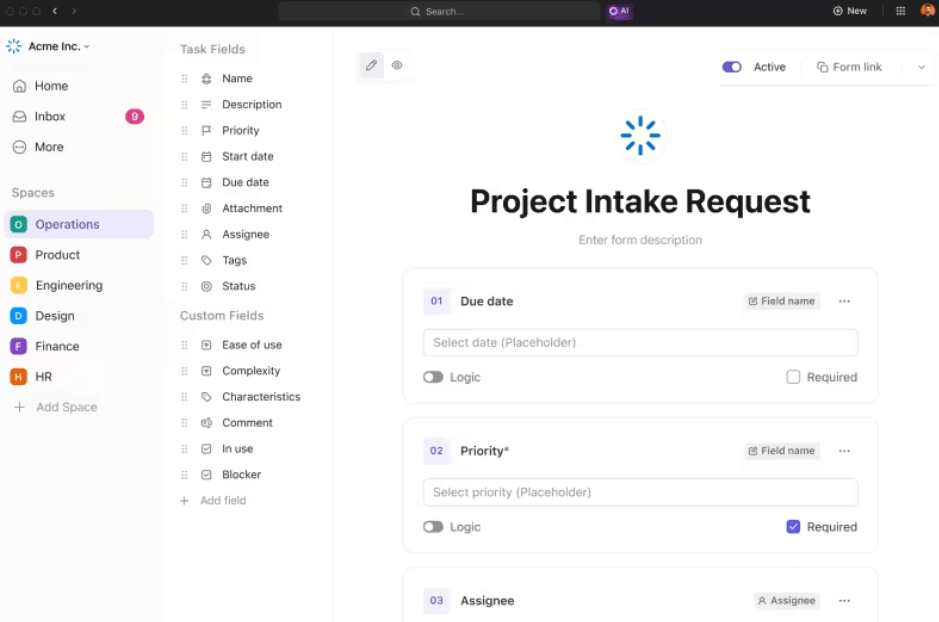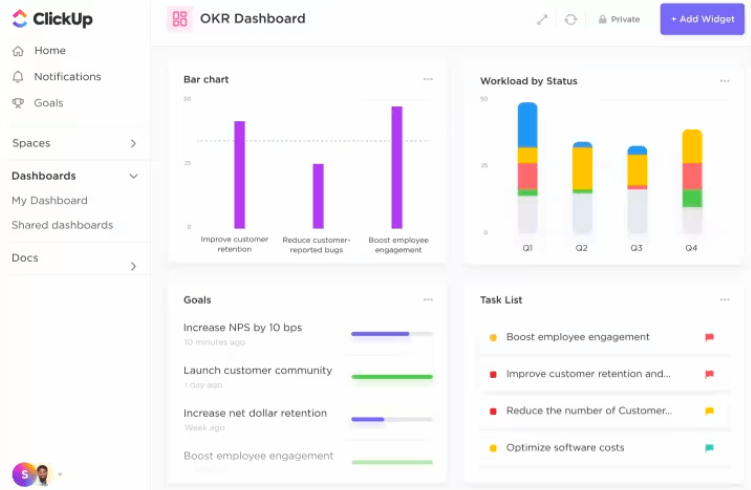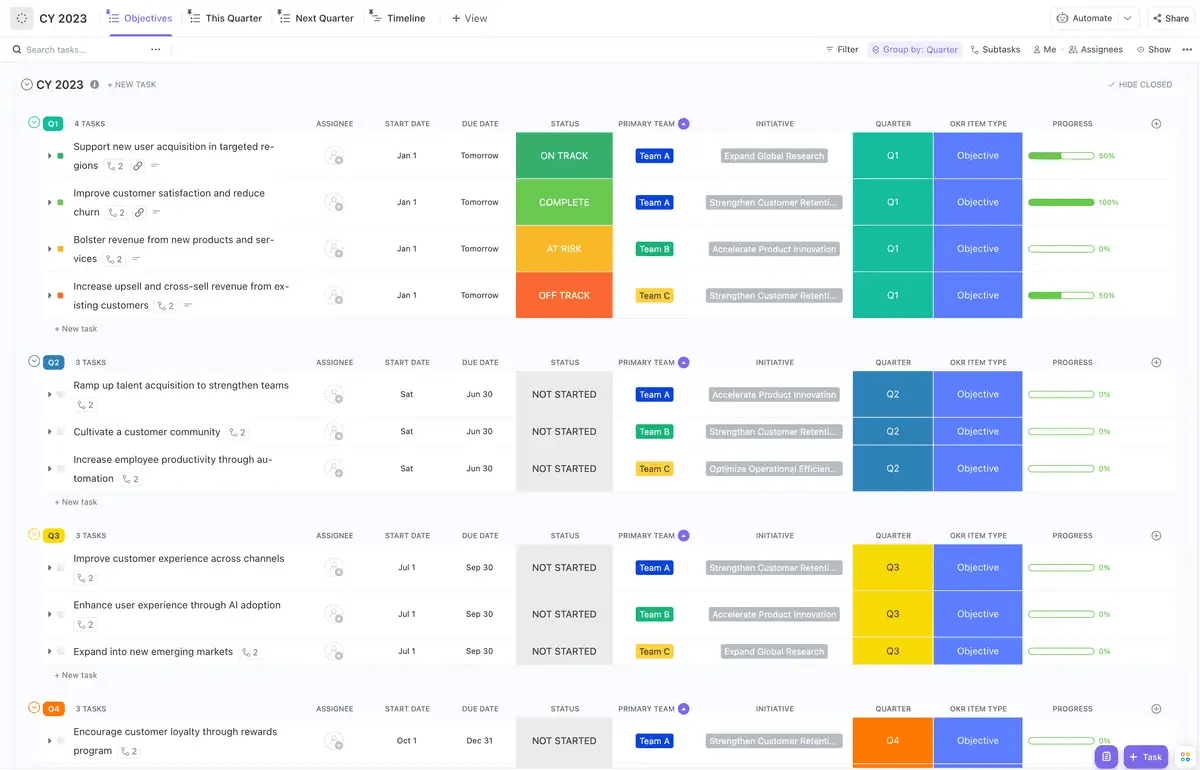تحل الإدارة الرشيقة للأداء معضلة شائعة - كيف يمكنك تقييم أداء فريقك وتحسينه بفعالية في مساحة عمل سريعة التطور؟
تركز الإدارة الرشيقة للأداء على تقديم الملاحظات في الوقت المناسب، وإجراء عمليات مراجعة متكررة، وتحديد أهداف التطوير الوظيفي المستقبلية للموظفين. ظهر هذا النهج استجابةً للحاجة المتزايدة إلى المرونة والقدرة على التكيف في مكان العمل وهو مستوحى من المنهجيات المستخدمة في إدارة المشاريع الرشيقة لا سيما أجايل سكروم .
ويحل نظام إدارة الأداء الرشيق محل الجلسات المطولة لتحديد الأهداف وحلقات التغذية الراجعة غير المتكررة في أنظمة إدارة الأداء التقليدية. فهو يخلق تغذية راجعة مستمرة وتواصل تعاوني. ونتيجة لذلك، هناك مواءمة أفضل للأهداف التي تمكّن موظفيك.
دعونا نفكك النهج الرشيق لإدارة الأداء.
إطار عمل إدارة الأداء الرشيق
الاعتماد فقط على التقييمات السنوية قد لا يكون كافياً في بيئة ديناميكية وسريعة الإيقاع. يشمل نموذج إدارة الأداء الرشيق المصمم خصيصًا لمكان العمل الحديث العناصر التالية:
- تقييمات متكررة: تشجع هذه الطريقة على إجراء مراجعات أقصر وأكثر انتظامًا. وهي عبارة عن اجتماعات فردية أسبوعية أو نصف أسبوعية - وهي فرصة لمناقشة التقدم المحرز ومعالجة العوائق والاحتفال بالمكاسب. هذه الاجتماعات السريعة تفيدفرق العمل الرشيقةحيث تحافظ على توافق الجميع وتحفيزهم
- تتبع الأهداف التفصيلية: تخلص من أهداف الأداء الغامضة من أجل نهج أكثر تفصيلاً. فكر في أهداف SMART (أهداف محددة وقابلة للقياس وقابلة للتحقيق وذات صلة ومحددة زمنيًا) مقسمة إلى مراحل أصغر وأكثر قابلية للإدارة
- التعليقات من مصادر خارجية: يمكنك تشجيع التغذية الراجعة من 360 درجة من خلال هذا النهج للعمليات الرشيقة، وتبسيط جمع الملاحظات والرؤى من قادة الفريق، وتحديد مجالات التحسين
- التطوير المستمر: التطوير المستمر: تحويل المقابلات الفردية المنتظمة إلى فرص لمناقشة التطلعات المهنية وتوفير التدريب الذي يساعد الموظفين على تحقيق كامل إمكاناتهم
| _نصيحة: _ الاستفادة من أدوات الإدارة الشاملة /href/https://clickup.com/blog/performance-management-tools//performance أدوات الإدارة /%href/ لإدارة الأداء بسلاسة وتسهيل /href/https://clickup.com/blog/agile-workflow//agile سير العمل /%href/. |
تختلف الإدارة الرشيقة للأداء عن مناهج إدارة الأداء التقليدية بعدة طرق. إليك لمحة سريعة عن الاختلافات الرئيسية:
| ميزة | إدارة الأداء التقليدية | إدارة الأداء الرشيقة | |
|---|---|---|---|
| التغذية الراجعة | سنوية، أحادية الجانب | مستمرة، ثنائية الاتجاه | |
| عمليات التحقق | غير متكررة، طويلة | متكررة، قصيرة | |
| أهداف | غامضة، سنوية | مبهمة، سنوية | ذكية، تعاونية |
| مصدر التغذية الراجعة | مصدر التغذية الراجعة | مركزية المدير | 360 درجة |
| التركيز | الأداء السابق | فرص التطوير، النمو المستقبلي |
فوائد وعيوب إدارة الأداء الرشيقة ## فوائد وعيوب إدارة الأداء الرشيقة
مع اتباع نهج جديد لإدارة الأداء مثل الإدارة الرشيقة، من الضروري الموازنة بين الإيجابيات والسلبيات حتى تتمكن من التنقل في عملية التنفيذ بسلاسة.
دعنا نستكشف الفوائد التي تجعل نظام إدارة الأداء الرشيق جذاباً، ثم نتناول بعض العيوب المحتملة وكيفية التغلب عليها.
فوائد تطبيق إدارة الأداء الرشيقة:
- تحسين مشاركة الموظفين وتعاون الفريق: تُبقي الملاحظات والمتابعة المنتظمة الموظفين يشعرون بالتقدير والتفاعل مع الفريق، بينما يضمن تحديد الأهداف التعاونية أن يعمل الجميع على تحقيق نفس الأهداف
- زيادة فرص التعلّم والتطوير: من خلال المراجعات المنتظمة والتغذية الراجعة المنتظمة، يمكنك تحديد الفجوات في المهارات بشكل أفضل وتقديم تدريب مستهدف في الوقت الفعلي
- تعزيز المرونة والقدرة على التكيف: من خلال إدارة الأداء المرنة، يمكنك التكيف والتطور في الوقت الفعلي، والاستجابة بسرعة للتغيرات في الأهداف والأولويات
- تحسين عملية اتخاذ القرار: توفر عمليات التحقق المنتظمة وتتبع التقدم المحرز بيانات قيمة لاتخاذ القرارات المستقبلية. يمكنك تكييف خطط التطوير وتحسين أداء الفريق، مما يؤدي إلى زيادة الكفاءة وتحقيق نتائج أفضل
العيوب المحتملة وكيفية التخفيف من حدتها:
- الالتزام بوقت المديرين: تتطلب عمليات التدقيق المتكررة استثمار الوقت من المديرين. استخدامأدوات إدارة المشروع لإدارة المهام يمكن أن يساعد في تنظيم هذه العملية
- التغذية الراجعة الزائدة: في حين أن التغذية الراجعة أمر بالغ الأهمية، إلا أن المناقشات المطولة دون نتائج عملية يمكن أن تكون مربكة. ركز على تقديم ملاحظات قابلة للتنفيذ ومحددة أثناء عمليات التدقيق لزيادة تأثيرها إلى أقصى حد
- غياب التوثيق الرسمي: غالباً ما تعتمد إدارة الأداء الرشيقة على المحادثات غير الرسمية بدلاً من التوثيق الرسمي. تخلص من التحديات في تتبع التقدم والأداء من خلالقوالب مراجعة الأداء. دمج كل من الملاحظات غير الرسمية والمراجعات الدورية في تقييم الأداء وتوثيقها على حد سواء لتتبع التقدم التدريجي
كيفية تنفيذ إدارة الأداء الرشيقة
إن بناء نظام رشيق لإدارة الأداء يمكن أن يهيئ مؤسستك للنجاح في سوق متقلب. ومع ذلك، فإن دمجها في مؤسستك يمكن أن يشكل تحدياً، خاصة إذا كنت تنتقل من عملية إدارة الأداء التقليدية.
فيما يلي الخطوات الرئيسية لضمان التنفيذ السلس وتجنب التعطيل:
1. ابدأ على نطاق صغير واجمع الملاحظات
إدارة الأداء الرشيقة هي محادثة مستمرة تركز على التطوير. البدء على نطاق صغير يسمح ببيئة محكومة لـ
- اختبار برنامج تجريبي: تجربة عملية إدارة الأداء بالكامل، والأدوات، وتكرار عمليات التحقق من الأداء في مجموعة أصغر. يساعد ذلك على تحديد أي تحديات أو مجالات للتحسين قبل تعميمه على مستوى المؤسسة
- بناء الزخم: يمكن لبرنامج تجريبي ناجح مع تعليقات إيجابية للمشاركين أن يبني الحماس والزخم لتعميمه على نطاق أوسع. يرى الموظفون الفوائد المحتملة قبل أن يُطلب منهم تبني النظام الجديد بالكامل
- تحديد المشاكل الخفية: يمكن للبرنامج التجريبي أن يكشف عن تحديات غير متوقعة خاصة بالقوى العاملة أو ثقافة شركتك. فربما تحتاج بعض الفرق إلى تدريب إضافي، أو أن أدوات التواصل المختارة لا تناسب الاحتياجات تماماً. تضمن معالجة هذه المشكلات في وقت مبكر تطبيقًا أكثر سلاسة في جميع أنحاء المؤسسة
لإطلاق برنامجك التجريبي بفعالية، يجب عليك أيضاً فهم ممارسات إدارة الأداء الحالية في مؤسستك. إليك كيفية جمع المعلومات القيمة:
استبيانات الموظفين
قم بإعداد استبيانات مجهولة الهوية لقياس شعور الموظفين تجاه أهداف إدارة الأداء في نظام الإدارة الحالي.
اطرح أسئلة مثل:
- ما مدى رضاك عن عملية مراجعة الأداء الحالية؟
- هل تتلقى ملاحظات بناءة كافية على مدار العام؟
- ما الذي يجعل مراجعات الأداء أكثر قيمة بالنسبة لك؟
مجموعات تركيز المديرين
تنظيم مجموعات تركيز مع المدراء لمناقشة التحديات التي تواجههم مع النظام الحالي.
فيما يلي بعض المطالبات:
- ما هي أكبر المشاكل التي تواجهها مع مراجعات الأداء؟
- ما الذي سيسهل عليك تقديم ملاحظات مفيدة لأعضاء فريقك؟
- ما هي المخاوف التي تراودك بشأن الانتقال إلى نموذج مراجعة أكثر تواتراً؟
قم بتحليل الملاحظات الواردة من هذه المصادر وصمم برنامجك التجريبي وفقاً لاحتياجاتك الخاصة. هذا يزيد من احتمالية نجاح التنفيذ والتجربة الإيجابية بشكل عام داخل المؤسسة الرشيقة.
2. استخدم الأدوات الرقمية المناسبة
قم بتطبيق الأدوات المناسبة لضمان النجاح المستمر لنظام إدارة بيانات الأداء الخاص بك. تتضمن الميزات التي يجب مراعاتها ما يلي:
- تحديد الأهداف وتتبعها: يجب أن تسمح أدوات إدارة الأداء الرشيقة الخاصة بك بتحديد أهداف SMART على مستوى الأفراد والفريق
- إدارة تسجيل الوصول: ابحث عن أداة تسهل جدولة عمليات تسجيل الوصول، وإرسال التذكيرات، وتتبع نقاط المناقشة وعناصر الإجراءات
- إدارة الملاحظات: يجب أن تدعم الأداة تقديم الملاحظات وتلقيها بصيغ مختلفة، مثل النصوص أو التسجيلات الصوتية أو مؤتمرات الفيديو. ضع في اعتبارك الميزات الخاصة بخيارات التغذية الراجعة مجهولة الهوية، وهو أمر بالغ الأهمية للتغذية الراجعة من 360 درجة
- التقارير والتحليلات: تتبع الأداء العام للفريق والأداء الفردي من خلال تقارير ولوحات معلومات ثاقبة. ابحث عن الميزات التي تصور الاتجاهات وتحديد مجالات التحسين وقياس تأثير برامج التعلم والتطوير
- الاندماج: اختر أداة تتكامل بسلاسة مع الأنظمة الحالية أو أدوات الاتصال أو منصات إدارة المشاريع لتجنب انعزال البيانات وتبسيط التواصل وسير العمل
- واجهة سهلة الاستخدام: يجب أن تكون واجهة الأداة سهلة الاستخدام ومتاحة لكل من المديرين والموظفين ذوي المستويات المختلفة من الخبرة التقنية
- التوافق مع الأجهزة المحمولة: ضع في اعتبارك أداة متوافقة مع الأجهزة المحمولة للسماح للموظفين والمديرين بالوصول إلى معلومات الأداء وتقديم الملاحظات أثناء التنقل

استخدم برنامج ClickUp لإدارة المشاريع الرشيقة من ClickUp للتنفيذ الناجح لإدارة الأداء الرشيق منصة ClickUp لإدارة المشاريع الرشيقة من ClickUp العديد من المبادئ والمنهجيات والميزات الرشيقة لإدارة الأداء الرشيقة الفعالة.
- تحديد أهداف واضحة وربطها بالمشاريع أو المهام باستخدامأهداف ClickUp. تتبع التقدم المحرز من خلال ميزات مثل إدارة عبء العمل ولوحات المعلومات والحقول المخصصة لقياس النجاح مقابل الأهداف
- تعزيز عمليات التحقق والتعليقات المنتظمة من خلال ميزة ClickUp @التعليقات والمناقشات حول المهام أو المشاريع
- احصل على رؤى في الوقت الفعلي حول تقدم الفريق وقدراته وسرعة المشروع باستخدام لوحات المعلومات الآلية من ClickUp. تساعد المخططات البيانية للإنجاز/التراجع في تتبع التقدم المحرز في السباق وتحليل العمل المنجز مقابل الأهداف
3. تحديد الأهداف والنتائج الرئيسية
الأهداف والنتائج الرئيسية (OKRs) هي حجر الزاوية في عملية إدارة الأداء الرشيقة. فهي إطار عمل لتحديد أهداف واضحة وقابلة للقياس للأفراد والفرق والمؤسسة بأكملها.
الأهداف
ضع وصفًا نوعيًا طموحًا لما تريد تحقيقه خلال إطار زمني محدد (عادةً ما يكون ربع سنوي أو عام). يجب أن تكون ملهمة وصعبة ومحددة زمنيًا.
مثال: "أن تصبح رائدًا في مجال رضا العملاء بحلول الربع الرابع"
النتائج الرئيسية
حدد مقاييس محددة وقابلة للقياس لتتبع التقدم المحرز نحو تحقيق الهدف. يجب أن تكون محددة بوضوح ويمكن التحقق منها ولها قيمة أو نتيجة مستهدفة.
مثال: "زيادة صافي نقاط المروجين (NPS) من 60 إلى 70 بحلول الربع الرابع" أو "تقليل معدل تراجع العملاء بنسبة 5% بحلول الربع الرابع".
فيما يلي تفصيل لكيفية تنفيذ OKRs ضمن نظام إدارة الأداء الرشيق (APM):
- التعاون: بناء الملكية والتأييد من خلال إشراك المديرين والموظفين في تحديد نتائج الأداء الجيدة بشكل تعاوني
- الموافقة المتتالية على النتائج النهائية: مواءمة فريق العمل والأهداف المؤسسية الأوسع نطاقًا مع الأهداف المؤسسية الأوسع نطاقًا
- الأهداف الذكية: تأكد من أن تكون أهداف OKRs محددة وذكية
- التتبع والمراجعة: جدولة عمليات مراجعة منتظمة (شهرية أو نصف شهرية) لتتبع التقدم المحرز في نتائج الأداء. قم بإجراء التعديلات حسب الحاجة للحفاظ على تحفيز الجميع
قم بإنشاء وتكوين OKRs المصممة خصيصًا لتلبية الاحتياجات الفريدة لفريقك باستخدام قالب OKRs الخاص ب ClickUp
قالب OKRs الخاص ب ClickUp أداة ممتازة للتخطيط وتحديد الأهداف للأفراد والفرق. استخدمه لتحديد الهيكل الأساسي لتطوير OKRs عبر المجالات الوظيفية داخل مؤسستك. بعد ذلك، يمكنك بسهولة تقسيم الأهداف الضخمة إلى أهداف OKRs قابلة للتحقيق ومراقبة التقدم المحرز في لمحة سريعة باستخدام الحالات المخصصة في قائمة OKR.
4. احتضان التغذية الراجعة بزاوية 360 درجة
غالبًا ما تعتمد مراجعات الأداء التقليدية على منظور المدير فقط. ويتخذ النظام الرشيق لمراجعات الأداء السنوية للإدارة نهجًا أكثر شمولية من مراجعات الأداء التقليدية. التغذية الراجعة بزاوية 360 درجة تتضمن رؤى من مصادر متعددة، مما يوفر صورة أكثر شمولاً لأداء الموظف ونقاط قوته.
ابدأ بإدخال التقييم الذاتي وملاحظات الأقران أثناء مناقشات تسجيل الدخول. ادمج تدريجيًا ملاحظات المديرين ومحادثات التطوير المستمرة، وفكر في دمج ملاحظات العملاء اعتمادًا على دور الموظف.
شجّع على تأطير عملية التغذية الراجعة بأكملها كأداة للنمو والتطور المستقبلي، وليس كأداة للنقد. ضع في اعتبارك ملاحظات الأقران المجهولة في البداية لتشجيع الاستجابات الصادقة. دع الثقة تُبنى وتحول تدريجيًا نحو التغذية الراجعة التي يمكن تحديدها.
توفير التدريب على تقديم وتلقي الملاحظات البناءة على الأداء لتدريب المدراء لضمان تجربة إيجابية لجميع المعنيين.

التقط الردود ووجهها إلى الفريق المناسب في الوقت المناسب باستخدام نماذج ClickUp نماذج ClickUp مفيد لجمع الملاحظات من مصادر مختلفة، مثل الزملاء والمديرين وحتى العملاء.
تتيح لك هذه الأداة:
- إنشاء نماذج ملاحظات مخصصة: صمم هذه النماذج حسب احتياجاتك الخاصة. على سبيل المثال، يمكن للمديرين إنشاء نموذج ملاحظات لتقديم ملاحظات للموظفين، ويمكن للموظفين إنشاء نموذج لتقديم ملاحظات متكررة لبعضهم البعض
- جمع الملاحظات بشكل مجهول: هذا يزيد من مشاركة الموظفين ويشجع على تقديم ملاحظات صادقة
- تتبع الملاحظات: استخدم هذه النماذج لتتبع الملاحظات مع مرور الوقت. يمكن أن يساعد ذلك في تحديد الاتجاهات والأنماط في أداء الموظفين
5. تتبع الأداء وتقديم الحوافز
تزدهر إدارة الأداء الرشيقة في ثقافة تشجع على التعلم والتحسين المستمر. يعد تتبع مقاييس الأداء اليومية وتقديم حوافز مصممة بشكل جيد أمرًا ضروريًا لدفع إدارة الأداء المستمر ودورة التغذية الراجعة المستمرة.
تتبع الأداء: التوجيه والتحفيز
- حلقة التغذية الراجعة المستمرة: مراقبة التقدم المحرز نحو تحقيق الأهداف من خلال عمليات التحقق المنتظمة. تتبع مقاييس الأداء ونقاط البيانات الملموسة للمناقشة، ومساعدة الموظفين على فهم نقاط القوة والضعف ومجالات التحسين
- التركيز على النتائج: التركيز على النتائج أكثر من النشاط. تتبع مؤشرات الأداء الرئيسية (KPIs) المتوافقة مع OKRs لضمان أن الجميع يعمل على تحقيق ما هو مهم
الحوافز: الاعتراف والتعزيز
- التحفيز والمواءمة: تحفيز الموظفين على التفوق وتحقيق الأهداف من خلال حوافز مصممة بشكل جيد
- التركيز على الأشياء الصحيحة: تحفيز تحقيق الأهداف الفردية والجماعية - وليس فقط المقاييس التقليدية مثل ساعات العمل - لتوجيه الموظفين بعيدًا عن الأنشطة التي لا تساهم في النجاح، وتوجيههم نحو الأنشطة التي تساهم في النجاح
ابدأ العمل مع قالب مراجعة الأداء من ClickUp سهل الاستخدام والقابل للتخصيص بالكامل
قالب مراجعة الأداء الخاص ب ClickUp يتيح لك التعاون في مراجعات أداء الموظفين وتتبعها، مما يساعدك على مكافأة وتعزيز الأداء المؤسسي.
ينشئ هذا القالب حلقة ملاحظات مستمرة من خلال ميزات مثل:
- حالات قابلة للتخصيص: تتبع التقدم المحرز في كل مراجعة من خلال حالات مثل "قيد التقدم" أو "يحتاج إلى مراجعة" أو "معتمد
- مقاييس الأداء والنتائج: إنشاء حقول مخصصة لالتقاط نقاط البيانات ذات الصلة المتوافقة مع OKRs. هذا يضمن لك التركيز على النتائج أكثر من المخرجات والتأكيد على مؤشرات الأداء الرئيسية المهمة
6. التكرار والتنقيح
التحسين المستمر أمر أساسي لمنهجيات إدارة الأداء الرشيقة. بمجرد أن يكون لديك مقاييس أداء قابلة للتنفيذ، ابدأ في إجراء التعديلات حسب الحاجة.
- ابدأ بالبحث عن المواضيع والأنماط المتكررة في بيانات الملاحظات. هل هناك جوانب محددة من عملية تسجيل الملاحظات تبدو مرهقة؟ هل تعكس مؤشرات الأداء الرئيسية المختارة النتائج المرجوة حقًا؟
- بعد ذلك، تحقق من وجود علاقة بين ممارسات إدارة الأداء المتقدم ومقاييس الأداء التي تقوم بتتبعها. على سبيل المثال، هل أدى تقديم ملاحظات أكثر تواتراً إلى انخفاض معدل دوران الموظفين؟
- حدد أولويات مجالات التحسين بناءً على تحليلك. ركز على معالجة القضايا الأكثر أهمية التي أثيرت في الملاحظات وتلك التي تنطوي على إمكانية إحداث أكبر تأثير
- ضع خطة ملموسة تحدد التغييرات التي ستجريها. قد يتضمن ذلك مراجعة تنسيق تسجيل الملاحظات، أو توفير تدريب إضافي على تحديد الأهداف، أو دمج أدوات جديدة لتسهيل تبادل الملاحظات
- قم بتوصيل التحسينات المخطط لها إلى المدراء والموظفين. اشرح الأساس المنطقي وراء التغييرات وكيف ستعود بالنفع على جميع المعنيين
| نصيحة احترافية:_ اختبر أي تغييرات مهمة تخطط لإجرائها على نطاق أصغر أولاً. يتيح لك ذلك تحديد أي تحديات غير متوقعة ومعالجتها قبل تعميمها على المؤسسة بأكملها. |

ساعد فريقك على العمل بذكاء أكبر والتحرك بشكل أسرع مع برنامج إدارة المشاريع من ClickUp منصة ClickUp لإدارة المشاريع الخاصة بـ ClickUp تساعد فرق الإدارة والموارد البشرية على معالجة وتنفيذ أداء الموظفين وإدارتهم من البداية إلى النهاية، بدءًا من جمع الملاحظات وتقديمها إلى وضع خطة واستراتيجية لتحسين أداء الموظفين.
تساعدك هذه المنصة المتكاملة لإدارة المشاريع والأداء على:
- تتبع التقدم والأداء: تساعدك لوحات المعلومات وميزات إعداد التقارير في ClickUp على تتبع التقدم والأداء بمرور الوقت. يمكن استخدام هذه المعلومات لتحديد مجالات التحسين وقياس مدى نجاح ممارساتك الرشيقة
- تسهيل التواصل والتعاون: يوفر ClickUp منصة مركزية لجميع مهام المشروع والوثائق والمناقشات. يمكن أن يساعد ذلك في تحسين التواصل والتعاون بين أعضاء الفريق، وهو أمر ضروري لتكرار وتحسين الممارسات الرشيقة
- التكرار بسهولة: استخدم ClickUp لتوثيق وتتبع نتائجالمنظورات الرشيقةحيث تعكس الفرق ما الذي سار بشكل جيد وما يمكن تحسينه. يمكن استخدام هذه المعلومات لإجراء تعديلات على ممارساتك الرشيقة ورفع مستوى الأداء بمرور الوقت
بناء محرك نمو مع ClickUp
إن تطبيق نهج رشيق في عملية إدارة الأداء هو طريق أكيد لخلق ثقافة التعلم المستمر والتطوير والتواصل المفتوح. تتدفق الفوائد إلى الخارج، مما يؤدي إلى تحسين التعاون ومواءمة الأهداف والنجاح التنظيمي.
مع تطور الشركات، ستصبح إدارة الأداء الرشيقة أكثر أهمية في بناء التماسك عبر المناطق الجغرافية. مع ظهور الذكاء الاصطناعي وتحليلات البيانات، نتوقع أن نرى المزيد من الحلول القائمة على التكنولوجيا لإدارة الأداء الرشيقة.
إن قدرة ClickUp على العمل كأداة لإدارة المشاريع الرشيقة ومنصة لإدارة الأداء تضعها في مكانة مثالية لمستقبل العمل. من خلال تبني التحول الرشيق والاستفادة من ClickUp، يمكن للمؤسسات تمكين فرقها وتحقيق الأهداف بفعالية أكبر واكتساب ميزة تنافسية كبيرة. اشترك في ClickUp اليوم مجانًا وقم ببناء استراتيجية إدارة الأداء الرشيقة الخاصة بك اليوم!
الأسئلة الشائعة ## الأسئلة الشائعة (FAQ)
1. ما الفرق بين إدارة الأداء التقليدية وإدارة الأداء الرشيقة؟
تركز إدارة الأداء التقليدية على المراجعات السنوية وتحديد الأهداف الصارمة، بينما يركز نموذج إدارة الأداء الرشيق على التغذية الراجعة المستمرة والقدرة على التكيف مع الأهداف وأولويات العمل المتغيرة.
2. ما هو هدف الأداء الرشيق؟
إن الهدف من إدارة الأداء الرشيق هو خلق التحسين المستمر، وتعزيز مهارات التواصل والتعاون، وتمكين الموظفين من تولي ملكية تطورهم.
3. ما هي النقطة الأساسية للأداء الرشيق؟
النقطة الأساسية في الإدارة الرشيقة هي أن المنظمات الرشيقة تتبنى المرونة والشفافية والتعاون لتحقيق الأهداف التنظيمية بكفاءة وفعالية في تكييف القدرات التنظيمية مع الظروف المتغيرة.



